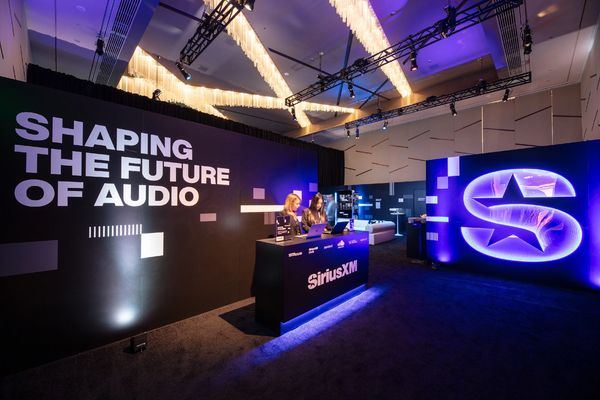Signed in as:
filler@godaddy.com
Signed in as:
filler@godaddy.com
Every year the biggest showcase for SiriusXM is the CES show in Las Vegas. How can we show our new and future concepts to OEMs besides power-points or single tablet?
Yes, I had to design and build screens, but also the "vehicle" itself...

The initial ask was to build a listening pod, fabricated to simulate a car with dash, backseats, windshields, etc. A lighting system that could respond to the system. Surrounding speakers with multi-zone listening.
We could showcase our latest, greatest, and upcoming, across multiple screens as OEMs started to add more and more inside the car.
So I created, ans speced, and reached out to our fabricator...
The initial estimate was about half a million.

What we really wanted was a multiple-screen dash, showing all those locations that SiriusXM could show and be interacted with.
And around these multiple areas of content, some lighting that interacts with the system (i.e. changing to red and blue when listener tunes to a NY Giants game), a wheel, pedals, and other car parts that make if feel more like a car, and a "windshield" displaying driving scenes.
Also this showcase transportable and un-badged (OEM agnostic).
So perhaps a big kiosk.

So I worked with the fabricator to create something more cost-effective, where SiriusXM would source the screens, wheel, etc., while the fabricator formed the shell.
This brought down the cost to about $50K.

Once we agreed on the concept, I worked with engineers to figure out what parts we needed and how they would interact with each other, The screens we needed to run the software, the proprietary brain of the system and what it needs to connect to (i.e. changing the channel on the wheel) along with how it all connects. I then speced out and sourced these parts.

I traced these parts and purchases (which was WAY more effort, and tense, than one would think, with parts being sold out, on hold, etc. We were on a budget AND schedule).
Did fulfillment for two sites, one for the fabricator building the kiosk, the other for our engineers to piece them together as a skeleton of screens and units to test.

The ball was rolling on the kiosk, but what about the actual showcase? The digital work needed to be done.
Screens that had never been created before needed concepting, What could go into a passenger screen, what would they expect and what can they actually do? How does selecting a channel in the lower console screen affect center, cluster, and passenger?
We produced story boards, wrote user stories, and built interaction flows with the Product team, and within two months had a full experience.

Like the large video game found in various bars, we had an oversized, interactive kiosk, complete with lighting and connected internal components, and multiple screens displaying the designs. The unit was boxed up and shipped to Las Vegas for CES.
The OEM partners were blown away, seeing what SiriusXM was planning across multiple screens.

The plan became to re-use the big kiosk to again showcase future concepts - more capability, concepts for on-boarding, pathing to our mobile app, and AI infused tastepicker
But we can also showcase new features available soon (in other words, works within our client today) in NEW kiosk(s)

We want to again keep costs down, so what can we do?
We had in years previously had more static kiosks, stand-ups with printed marketing, a unit with the current software, and speakers.
How can we upgrade them?

Working with the VPs who would do the presentations to our OEM partners, we planned to gut the old flat kiosks and remove static content
We could add TVs behind glass to give it a monolithic look, where we can then use the dynamic screen to call out key features and attract people from across the room.
Then add arms to hold tablets with our stand-alone product, or mobile devices to show the companion app.

Now the TV could display different content during different stages.
Worked with animation designers to create states like muted attract (when it's not the highlight of the presentation)...
...to highlighting features like search.

Back in the "Big Buck" kiosk, we needed new concepts. Each lead designer took sections, worked with product, and planned the future.
We researched what listeners were asking for, discussed with Product and Dev what was possible, built storyboards, wifeframes, and screens, and stitched them together for a complete experience.

We knew:
Working with Product and eve, I planned an AI tastepicker, using current AI that could be translated into the car.
Conversational and could be engaged at various moments.

With the additional tall kiosks to showcase current features, and the original kiosk with future concepts, it was a hit.
OEMs were engaged, excited to work with SiriusXM to get these features, and leadership was thrilled.
We use cookies to analyze website traffic and optimize your website experience. By accepting our use of cookies, your data will be aggregated with all other user data.